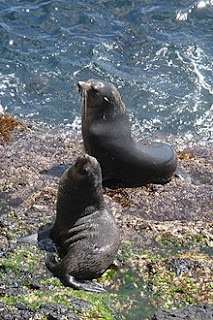 |
| Crew members at the rail, with Gough Island in the background. |
Each day here at Gough Island, once the helicopter operations are concluded or canceled due to weather, an announcement comes over the ship's PA system. "For the information of all hands, fishing is now permitted. Fishing is permitted." Within minutes, the forward deck is lined on both sides by crew members tossing hooked, baited, and weighted line overboard. So far I've seen them bring up three different species of fish, the fivefinger (which is brown with stripes like a bass), jacopever (bright orange), and bluefish (also called barrelfish or butterfish).
During helicopter ops (more on that in a post later this week), the deck is cleared of any non-essential personnel as cargo is brought up from the hold and loaded in this area.
I don't otherwise see too much of the crew, which is definitely a different experience for me. They eat in a different dining hall, and have a separate gym (and sauna). The ship is dry for them, so the only crew member we see in the bar is the bartender. It's nice to see many of them out on deck enjoying some leisure time once fishing is allowed. And they're all as keen as crew members and scientists alike on US ships that I've sailed with.
They were all very friendly towards me today as I walked the deck as a tourist (I never cared much for the sport). I peeked at the catch, which is kept in buckets that used to contain oil for the kitchen friers. Only a few have the rods and reels I'm used to seeing, mostly it's just straight fishing line and a plywood block with their name on it to claim a spot (see photo above).
I'm glad to see that the crew gets a morale boost from the experience. They all work tirelessly to make this cruise successful. Tomorrow the scientists will get a bit of a morale boost, as we're being shuttled over to Gough Island for some sight-seeing. It will be nice to step foot on land, and in such a remote place. Stay tuned for more on that experience!
I'm glad to see that the crew gets a morale boost from the experience. They all work tirelessly to make this cruise successful. Tomorrow the scientists will get a bit of a morale boost, as we're being shuttled over to Gough Island for some sight-seeing. It will be nice to step foot on land, and in such a remote place. Stay tuned for more on that experience!























